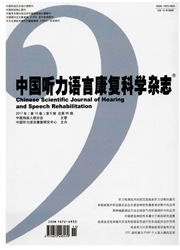

 中文摘要:
中文摘要:
目的:分析大前庭水管综合征(large vestibular aqueduct syndrome,LVAS)患者家系的SLC26A4基因突变方式并确定其是否致病。方法采集3个特殊LVAS家系的血样,测序分析SLC26A4基因型。采用在线软件SIFT、Polyphen-2预测这3个家系中所携带的罕见突变方式的致病性,利用排除法证明c.2343+69C>A的非致病性。结果共检出5种突变方式,其中4种为致病性基因突变。先证者基因型为IVS7-2A>G/c.1594A>C,IVS7-2A>G/c.1327G>C,IVS7-2A>G/c.1667A>G,均为LVAS。基因型为c.1594A>C/2343+69C>A,c.1327G>C/c.2343+69C>A,c.1667A>G/c.2343+69C>A的受检者听力正常。结论 SLC26A4基因c.2343+69C>A突变方式是非致病的基因多态;3个家系先证者的父母再次妊娠出现聋儿的风险为25%。
 英文摘要:
英文摘要:
Objective To sequence and analyze the pathogenesis of the mutation of SLC26A4 gene in 3 families of LVAS.Methods Blood samples and clinical data of 3 families of LVAS were collected. A pathogenesis analysis was conducted on the rare genemutation in the families using online software. Using a process of elimination to prove that c.2343+69C〉A is benign.Results We detected five SLC26A4 gene mutations from 3 families, and confirmed that four mutations out of them are pathogenic.The genotypes of IVS7-2A〉G/c.1594A〉C, IVS7-2A〉G/c.1327G〉C, IVS7-2A〉G/c.1667A〉G are the probands. The genotypes of c.1594A〉C/c.2343+69C〉A,c.1327G〉C/c.2343+69C〉A, c.1667A〉G/c.2343+69C〉A case have normal hearing.Conclusion According to our results, SLC26A4 c.2343+69C〉A is not likely to be a pathogenic mutation.If the parents of any proband of these three families want to rebirth, the newborn might have 25 percent chance to be with EVAS as the proband.
 同期刊论文项目
同期刊论文项目
 同项目期刊论文
同项目期刊论文
 期刊信息
期刊信息
